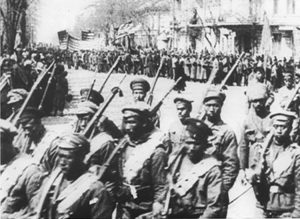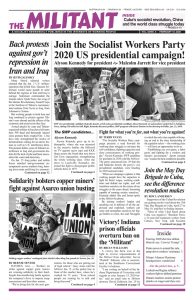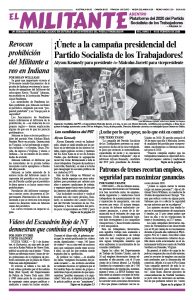
Russian President Vladimir Putin Jan. 15 announced “a major renewal,” which looks a lot like a plan to keep him in office indefinitely. His proposed changes to the constitution are being rolled out with great fanfare. This takes place as his popularity is falling and his 20-year rule faces deepening problems as workers confront falling living standards and social crisis.
Putin aims to shore up Russian capitalism in an era of world capitalist crisis, and with an economy heavily dependent on oil and gas exports that is weak compared to Washington and its other competitors. At the same time the Kremlin is seeking to shore up its international standing and defend its allies — as it did intervening in Syria to rescue the tottering dictatorship of Bashar al-Assad.
The government reorganization includes the resignation of Dmitry Medvedev as prime minister and replacement of much of the cabinet. It weakens future presidents and bolsters the State Council — a committee of top regional, security and military officials chaired by Putin — that would take on greater executive power.
This interim government is headed by newly appointed Prime Minister Mikhail Mishustin, a little-known but loyal former taxation minister.
In addition to paving the way for Putin to retain the reins of power after his presidency ends in 2024, the new setup is tasked with implementing his 12-point National Projects plan. This is a set of schemes to use state resources to modernize and diversify the capitalist economy, squeeze workers to boost productivity, and allocate some social spending to try and cushion the harsh conditions of life facing working people to quell unrest.
Real income of Russian workers fell 1.3% in the first half of 2019. Some 65% of Russian households have no savings. The government adopted new pension laws that will force workers to wait later — many until after the average life span — before they can claim a pension.
This social crisis is worsened by sanctions imposed by Washington and the EU that the imperialist powers say were in reprisal for Moscow’s seizure and occupation of Crimea in 2014.
Bonapartist regime
Putin, a former officer of the KGB, the Soviet secret police, rose to power as a capitalist-oriented economy and government emerged from the wreckage of the Stalinist police-state regime in the 1990s.
He acted as an arbiter standing above rival forces — the so-called oligarchy of newly emerged capitalist exploiters that had looted the former state-owned enterprises, and working people, who faced a deep social crisis. He put his KGB methods to work, rising in power through patronage and the arrest, torture or murder of bourgeois political opponents.
In 2000, the year before he became president, Putin said he would prevent Russia from being “relegated to the second or even third tier of global powers.”
He has since sought to restore some of Moscow’s former sway over its “near abroad” of former Soviet Republics like Ukraine. After Viktor Yanukovych, the Russian-backed Ukrainian president, was toppled by the popular Maidan uprising in 2014, Putin occupied Crimea and reinforced separatist paramilitary forces in Ukraine’s eastern provinces to break from Kyiv.
Putin set up the Eurasian Economic Union in 2015 seeking to ensnare former Soviet countries like Armenia, Kazakhstan, Belarus and Kyrgyzstan into a common trade bloc.
Using oil revenues he modernized much of the Russian military, one of the world’s largest, with a substantial nuclear arsenal bequeathed by the USSR’s collapse. But even with these moves, Putin’s 2019 military budget was $44 billion, compared to $716 billion for Washington.
Moscow’s rulers have tried to use their intervention in Syria to maintain influence and gain allies in the Middle East.
Putin identifies with czars, Stalin
Putin combines a hatred for the Russian Revolution of 1917 and the Bolshevik Party that led workers and farmers to power with bemoaning the downfall of the czarist empire, overthrown by the revolution, which had stood as the bulwark of semifeudal reaction in Europe for centuries.
The Bolshevik Revolution, under the communist leadership of V.I. Lenin, marked a tremendous advance for the world’s toilers, the first revolution in history to overthrow capitalist exploitation and oppression. A government was formed based on soviets — councils of workers, peasants and soldiers deputies. This example of workers and peasants taking power inspired millions across the globe, hastening the end of the bloody imperialist slaughter of World War I.
Revolutionary-minded workers worldwide organized to build Communist Parties modeled on the Bolsheviks to fight for power.
The Bolshevik-led government organized workers to take control of industry, to learn how to produce for society’s needs, not for profit. It supported peasants’ struggles by nationalizing big landholdings and distributing land to the tillers. It led working people to establish new socialized property relations, the foundation of the world’s first workers state.
Lenin’s proletarian internationalist course supported the right of oppressed peoples within the old czarist “prison house of nations” to self-determination. In the last year of his life, he led a fight — against a developing caste led by Joseph Stalin — for a voluntary federation of these oppressed nations with Russia, formed “on the basis of full equality.”
Many of these gains were reversed over the next decade. Revolutionary upsurges by workers and farmers in Germany and elsewhere were defeated and the Russian Revolution isolated. The workers and farmers government faced reactionary forces in a civil war and invasion by over a dozen imperialist powers, including the U.S. rulers.
In this context, Stalin led a rising bureaucratic layer seeking to reverse the proletarian course followed by Lenin. Amid war and deepening economic crisis, workers and farmers were pushed out of politics. Frame-up trials and the murder of revolutionaries, forced collectivization of agriculture and “gulags” of forced labor camps marked Stalin’s bloody counterrevolution reversing the political gains of the Russian Revolution.
Despite this, the Soviet Union, however hideously bureaucratically distorted, was still based on state property, not capitalist control, which workers needed to defend. The workers state finally came to an end in the years after the 1991 disintegration of the Union of Soviet Socialist Republics.
Putin today says Stalin brought order to Russia, with whatever errors he might have committed. He denounces Lenin’s Marxist policy on the right of oppressed nations to self-determination, saying it created an “atomic time bomb” that decades later blew apart the USSR.
But it was the Stalinist counterrevolution’s Great Russian chauvinist resubjugation of smaller nationalities that made this rupturing along national lines inevitable.
After over six decades of Stalinism’s anti-working-class rule in Russia, and destruction of revolutionary communist parties worldwide, the Soviet Union imploded and came apart. Capitalism was reestablished on its ashes, and Putin, out of its political police apparatus, rose to power.
Today he is determined to maintain his rule, convinced he can carve out order and security for “Mother Russia” in a world of growing capitalist disorder.
Small wonder he is determined to obscure the powerful history of the Bolshevik Revolution that brought workers and farmers to power.

